PEUGEOT PARTNER TEPEE ELECTRIC 2017 Service Manual
Manufacturer: PEUGEOT, Model Year: 2017, Model line: PARTNER TEPEE ELECTRIC, Model: PEUGEOT PARTNER TEPEE ELECTRIC 2017Pages: 252, PDF Size: 9.89 MB
Page 41 of 252
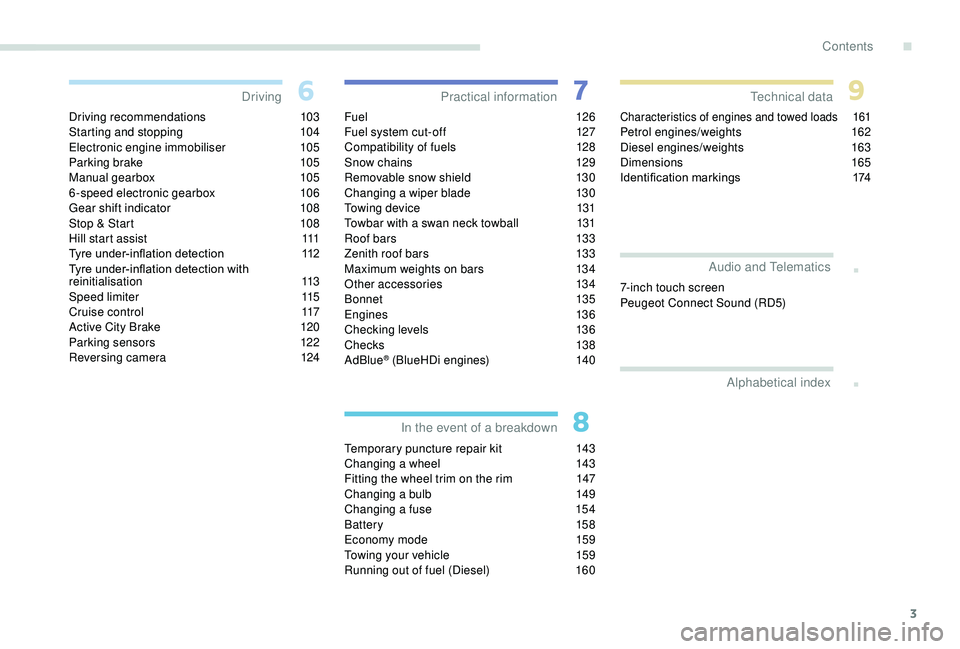
3
.
.
Driving recommendations 103
Starting and stopping 1 04
Electronic engine immobiliser
1
05
Parking brake
1
05
Manual gearbox
1
05
6-speed electronic gearbox
1
06
Gear shift indicator
1
08
Stop & Start
1
08
Hill start assist
1
11
Tyre under-inflation detection
1
12
Tyre under-inflation detection with
reinitialisation
113
Speed limiter
1
15
Cruise control
1
17
Active City Brake
1
20
Parking sensors
1
22
Reversing camera
1
24Fuel 1
26
Fuel system cut-off 1 27
Compatibility of fuels
1
28
Snow chains
1
29
Removable snow shield
1
30
Changing a wiper blade
1
30
Towing device
1
31
Towbar with a swan neck towball
1
31
Roof bars
1
33
Zenith roof bars
1
33
Maximum weights on bars
1
34
Other accessories
1
34
Bonnet
13 5
Engines
1
36
Checking levels
1
36
Chec ks
13 8
AdBlue
® (BlueHDi engines) 1 40
Temporary puncture repair kit
1
43
Changing a wheel
1
43
Fitting the wheel trim on the rim
1
47
Changing a bulb
1
49
Changing a fuse
1
54
Battery
158
Economy mode
1
59
Towing your vehicle
1
59
Running out of fuel (Diesel)
1
60
Characteristics of engines and towed loads 1 61Petrol engines/weights 162
Diesel engines/weights 1 63
Dimensions
165
Identification markings
1
74
DrivingPractical information
In the event of a breakdown Technical data
Alphabetical index
Audio and Telematics
7-inch touch screen
Peugeot Connect Sound (RD5)
.
Contents
Page 42 of 252

4
Instruments and controls1.Lighting and direction indicator control
stalk.
2. Instrument panel with display.
3. Wiper/screenwash/trip computer control
stalk.
4. Ignition.
5. Audio system controls.
6. Driver's front airbag/horn.
7. Steering wheel height and reach
adjustment.
8. Cruise control/speed limiter controls.
9. Control panel: parking sensors, headlamp
beam adjustment, ESC, Stop & Start,
alarm (depending on country of sale).
10. Bonnet release.
11. Electric door mirror adjustment controls.
12 . Front window controls.
13. Switch panel: hazard warning lamps,
central locking, child lock (depending on
ve r s i o n).
14 . Cigarette lighter.
15. Heating/ventilation controls.
16. Electronic gearbox or Grip control
control.
17. Touch screen.
18. USB port (with electronic gearbox).
19. USB port (with manual gearbox).
Over view
Page 43 of 252
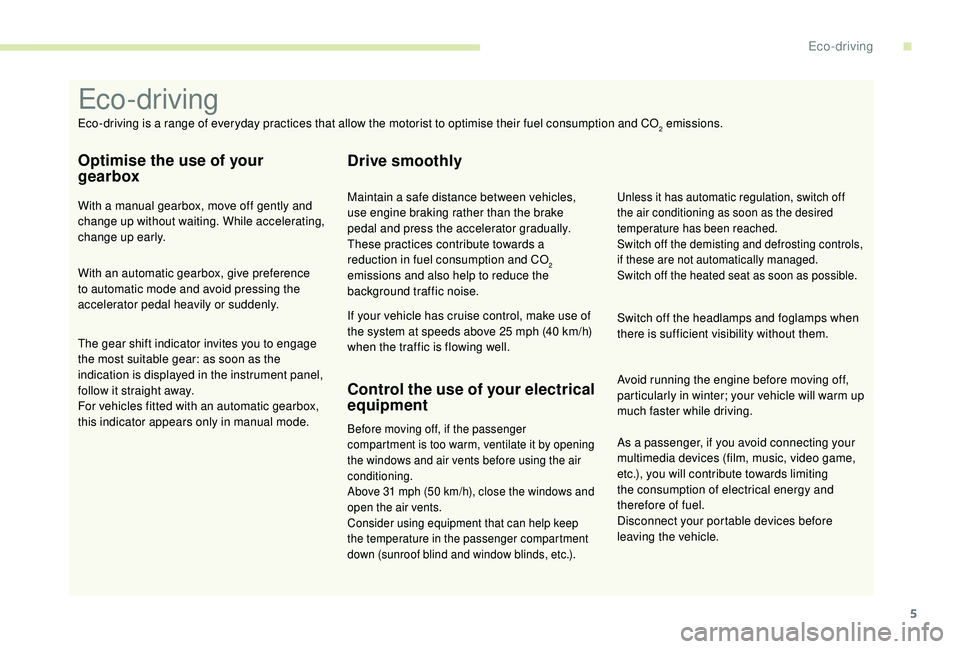
5
As a passenger, if you avoid connecting your
multimedia devices (film, music, video game,
etc.), you will contribute towards limiting
the consumption of electrical energy and
therefore of fuel.
Disconnect your portable devices before
leaving the vehicle.
Eco- driving
Eco-driving is a range of everyday practices that allow the motorist to optimise their fuel consumption and CO2 emissions.
Optimise the use of your
gearbox
With a manual gearbox, move off gently and
change up without waiting. While accelerating,
change up early.
With an automatic gearbox, give preference
to automatic mode and avoid pressing the
accelerator pedal heavily or suddenly.
The gear shift indicator invites you to engage
the most suitable gear: as soon as the
indication is displayed in the instrument panel,
follow it straight away.
For vehicles fitted with an automatic gearbox,
this indicator appears only in manual mode.
Drive smoothly
Maintain a safe distance between vehicles,
use engine braking rather than the brake
pedal and press the accelerator gradually.
These practices contribute towards a
reduction in fuel consumption and CO
2
emissions and also help to reduce the
background traffic noise.
If your vehicle has cruise control, make use of
the system at speeds above 25
mph (40 km/h)
when the traffic is flowing well.
Control the use of your electrical
equipment
Before moving off, if the passenger
compartment is too warm, ventilate it by opening
the windows and air vents before using the air
conditioning.
Above 31
mph (50 km/h), close the windows and
open the air vents.
Consider using equipment that can help keep
the temperature in the passenger compartment
down (sunroof blind and window blinds, etc.).
Switch off the headlamps and foglamps when
there is sufficient visibility without them.
Avoid running the engine before moving off,
particularly in winter; your vehicle will warm up
much faster while driving.
Unless it has automatic regulation, switch off
the air conditioning as soon as the desired
temperature has been reached.
Switch off the demisting and defrosting controls,
if these are not automatically managed.
Switch off the heated seat as soon as possible.
.
.
Eco-drivingsommaire
Page 44 of 252
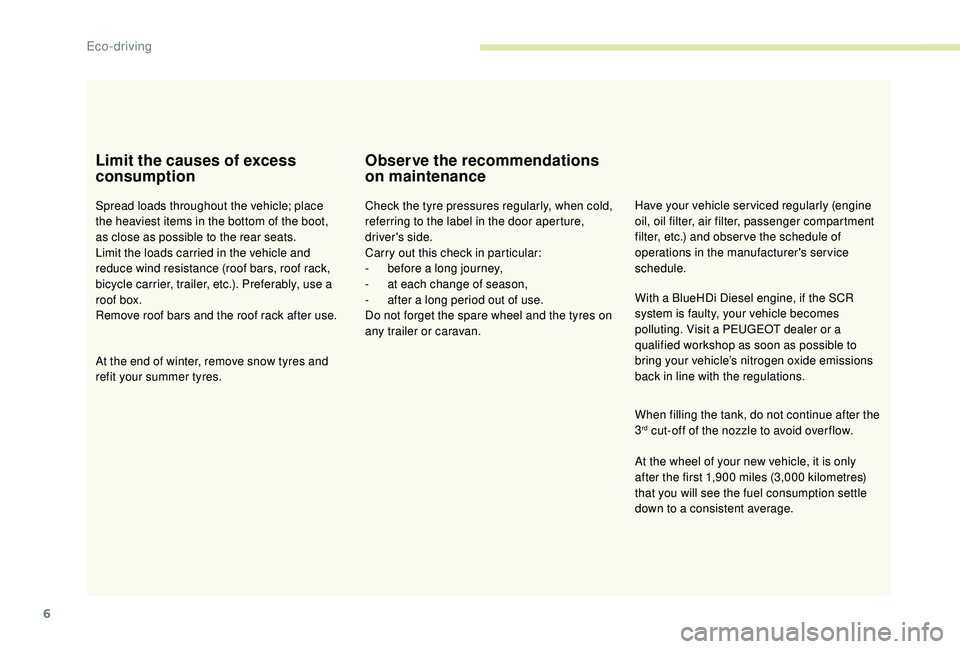
6
Limit the causes of excess
consumption
Spread loads throughout the vehicle; place
the heaviest items in the bottom of the boot,
as close as possible to the rear seats.
Limit the loads carried in the vehicle and
reduce wind resistance (roof bars, roof rack,
bicycle carrier, trailer, etc.). Preferably, use a
roof box.
Remove roof bars and the roof rack after use.
At the end of winter, remove snow tyres and
refit your summer tyres.
Observe the recommendations
on maintenance
Check the tyre pressures regularly, when cold,
referring to the label in the door aperture,
driver's side.
Carry out this check in particular:
-
b
efore a long journey,
-
a
t each change of season,
-
a
fter a long period out of use.
Do not forget the spare wheel and the tyres on
any trailer or caravan. Have your vehicle ser viced regularly (engine
oil, oil filter, air filter, passenger compartment
filter, etc.) and obser ve the schedule of
operations in the manufacturer's service
schedule.
When filling the tank, do not continue after the
3
rd cut-off of the nozzle to avoid over flow.
At the wheel of your new vehicle, it is only
after the first 1,900
miles (3,000 kilometres)
that you will see the fuel consumption settle
down to a consistent average. With a BlueHDi Diesel engine, if the SCR
system is faulty, your vehicle becomes
polluting. Visit a PEUGEOT dealer or a
qualified workshop as soon as possible to
bring your vehicle’s nitrogen oxide emissions
back in line with the regulations.
Eco-driving
Page 45 of 252
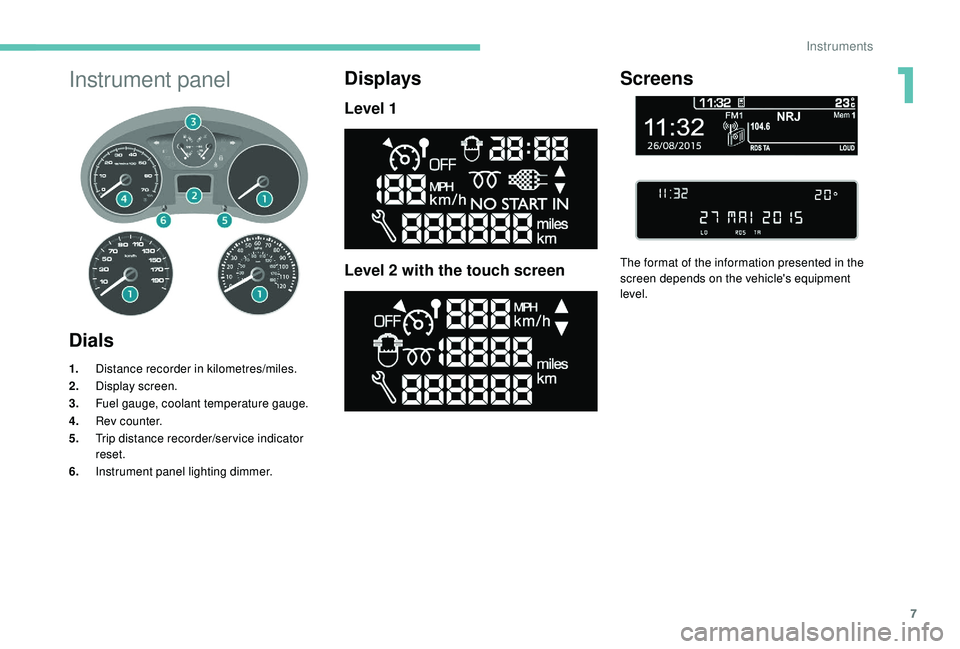
7
Instrument panel
Dials
1.Distance recorder in kilometres/miles.
2. Display screen.
3. Fuel gauge, coolant temperature gauge.
4. Rev counter.
5. Trip distance recorder/ser vice indicator
reset.
6. Instrument panel lighting dimmer.
Displays
Level 1
Level 2 with the touch screen
Screens
The format of the information presented in the
screen depends on the vehicle's equipment
level.
1
Instruments
Page 46 of 252

8
Warning and indicator lamps
Visual indicators informing the driver that
a system is in operation, switched off (on/
off indicator lamps) or has developed a fault
(warning lamps).
When the ignition is switched on
Certain warning lamps come on for a few
seconds when the vehicle's ignition is switched
on.
When the engine is started, these same
warning lamps should go off.
If they remain on, before driving refer to the
information on the warning lamp concerned.
Associated warnings
Certain lamps may come on in one of two
modes: fixed (continuous) or flashing.
Only by relating the type of lighting to the
operating status of the vehicle can it be
ascertained whether the situation is normal or
whether a fault has occurred.
In the event of a fault, the illumination of the
lamp may be accompanied by an audible signal
and/or a message.
Warning lamps
When the engine is running or the vehicle is
being driven, illumination of one of the following
warning lamps indicates a fault which requires
action on the part of the driver.
Any fault resulting in the illumination of a
warning lamp must be investigated further
using the associated message.
If you encounter any problems, contact a
PEUGEOT dealer or a qualified workshop.
Operation indicator lamps
If one of the following indicator lamps comes on
in the instrument panel and/or instrument panel
screen, this confirms that the corresponding
system has come into operation.
Deactivation indicator lamp
If this indicator lamp comes on, this confirms
that the corresponding system has been
switched off intentionally.
This may be accompanied by an audible signal
and a message being displayed.
Instruments
Page 47 of 252

9
Warning/indicator lampStateCause Action/Observations
Red warning/indicator lamps
STOPFixed, associated with
another warning lamp
and accompanied
by a message in the
screen. Major faults linked with the "Brake
fluid level", "Engine oil pressure
and temperature", "Engine
coolant temperature", "Electronic
brake force distribution" and
"Power steering" warning lamps. You must stop as soon as it is safe to do so.
Park, switch off the ignition and call a PEUGEOT
dealer or qualified workshop.
Engine coolant
temperature and
level Fixed, with the needle
in the red zone.
An abnormal increase in
temperature.
Park and switch off the ignition, then allow to cool down.
Check the level visually.
Flashing.
A drop in the engine coolant level. Contact a PEUGEOT dealer or a qualified workshop.
Engine oil pressure
and temperature Fixed while driving. Insufficient pressure or excessive
temperature.
Park and switch off the ignition, then allow to cool down.
Check the level visually. For more information on
Checking levels, refer to the corresponding section.
Fixed, even though the
level is correct. A major fault.
Have it checked by a PEUGEOT dealer or a qualified
workshop.
Battery charge Fixed. A fault in the charging circuit. Check the battery terminals. For more information on
the Battery, refer to the corresponding section.
Flashing. Active functions set to standby
(economy mode). For more information on the Battery
, refer to the
corresponding section.
Fixed, despite the
checks. A fault with the ignition or
injection system. Have it checked by a PEUGEOT dealer or a qualified
workshop.
1
Instruments
Page 48 of 252
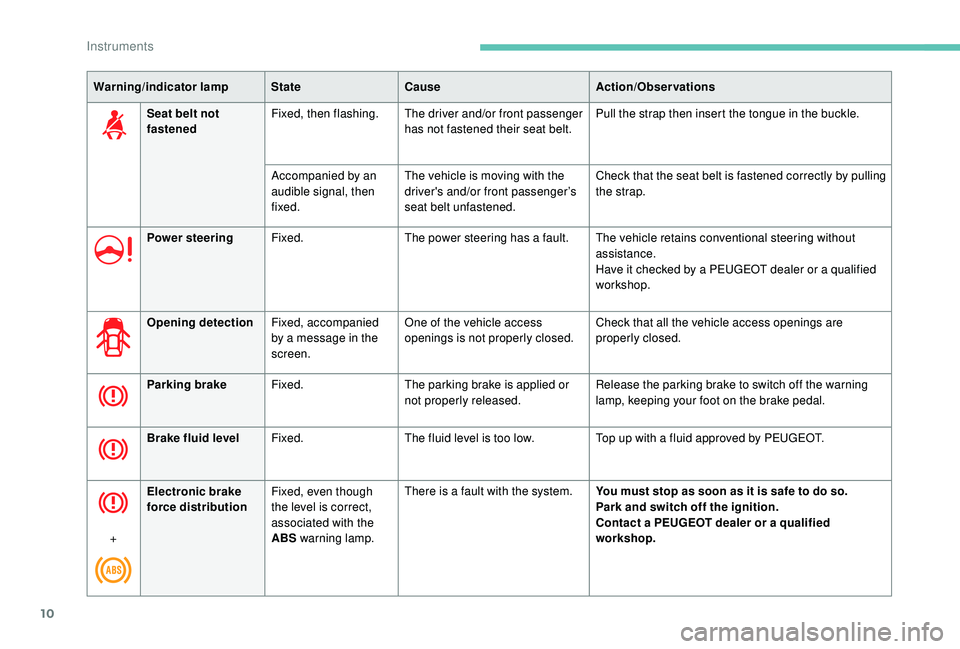
10
Warning/indicator lampStateCause Action/Observations
Seat belt not
fastened Fixed, then flashing.
The driver and/or front passenger
has not fastened their seat belt. Pull the strap then insert the tongue in the buckle.
Accompanied by an
audible signal, then
fixed. The vehicle is moving with the
driver's and/or front passenger’s
seat belt unfastened. Check that the seat belt is fastened correctly by pulling
the strap.
Power steering Fixed. The power steering has a fault. The vehicle retains conventional steering without
assistance.
Have it checked by a PEUGEOT dealer or a qualified
workshop.
Opening detection Fixed, accompanied
by a message in the
screen. One of the vehicle access
openings is not properly closed.
Check that all the vehicle access openings are
properly closed.
Parking brake Fixed. The parking brake is applied or
not properly released. Release the parking brake to switch off the warning
lamp, keeping your foot on the brake pedal.
Brake fluid level Fixed. The fluid level is too low. Top up with a fluid approved by PEUGEOT.
+ Electronic brake
force distribution
Fixed, even though
the level is correct,
associated with the
ABS
warning lamp. There is a fault with the system.
You must stop as soon as it is safe to do so.
Park and switch off the ignition.
Contact a PEUGEOT dealer or a qualified
workshop.
Instruments
Page 49 of 252
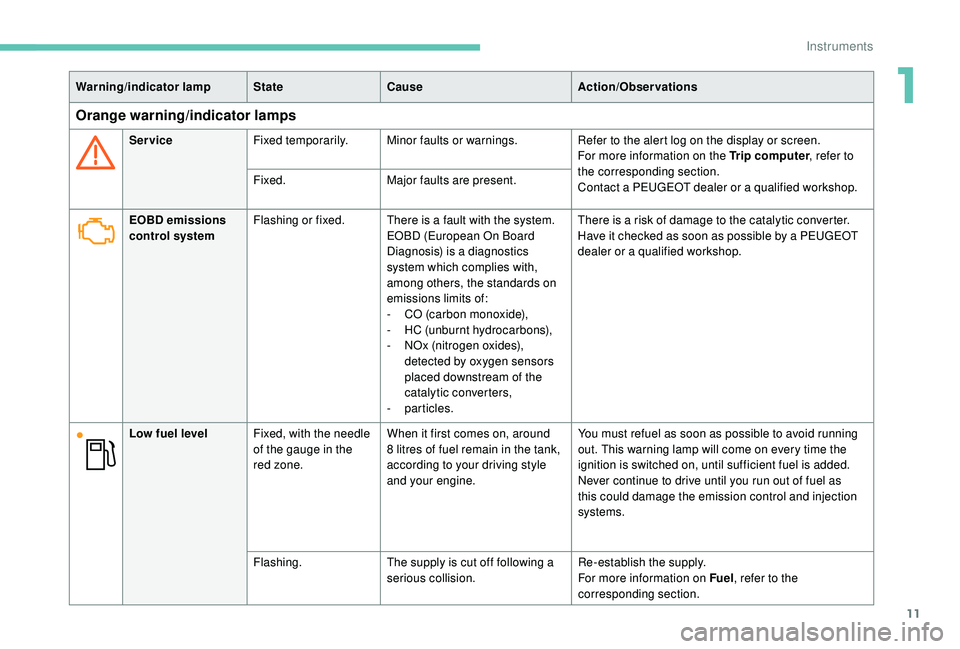
11
Warning/indicator lampStateCause Action/Observations
Orange warning/indicator lamps
ServiceFixed temporarily. Minor faults or warnings. Refer to the alert log on the display or screen.
For more information on the Trip computer , refer to
the corresponding section.
Contact a PEUGEOT dealer or a qualified workshop.
Fixed.
Major faults are present.
EOBD emissions
control system Flashing or fixed.
There is a fault with the system.
EOBD (European On Board
Diagnosis) is a diagnostics
system which complies with,
among others, the standards on
emissions limits of:
-
CO
(carbon monoxide),
-
H
C (unburnt hydrocarbons),
-
N
Ox (nitrogen oxides),
detected by oxygen sensors
placed downstream of the
catalytic converters,
-
particles.There is a risk of damage to the catalytic converter.
Have it checked as soon as possible by a PEUGEOT
dealer or a qualified workshop.
Low fuel level Fixed, with the needle
of the gauge in the
red zone. When it first comes on, around
8
litres of fuel remain in the tank,
according to your driving style
and your engine. You must refuel as soon as possible to avoid running
out. This warning lamp will come on every time the
ignition is switched on, until sufficient fuel is added.
Never continue to drive until you run out of fuel as
this could damage the emission control and injection
systems.
Flashing. The supply is cut off following a
serious collision. Re-establish the supply.
For more information on Fuel
, refer to the
corresponding section.
1
Instruments
Page 50 of 252
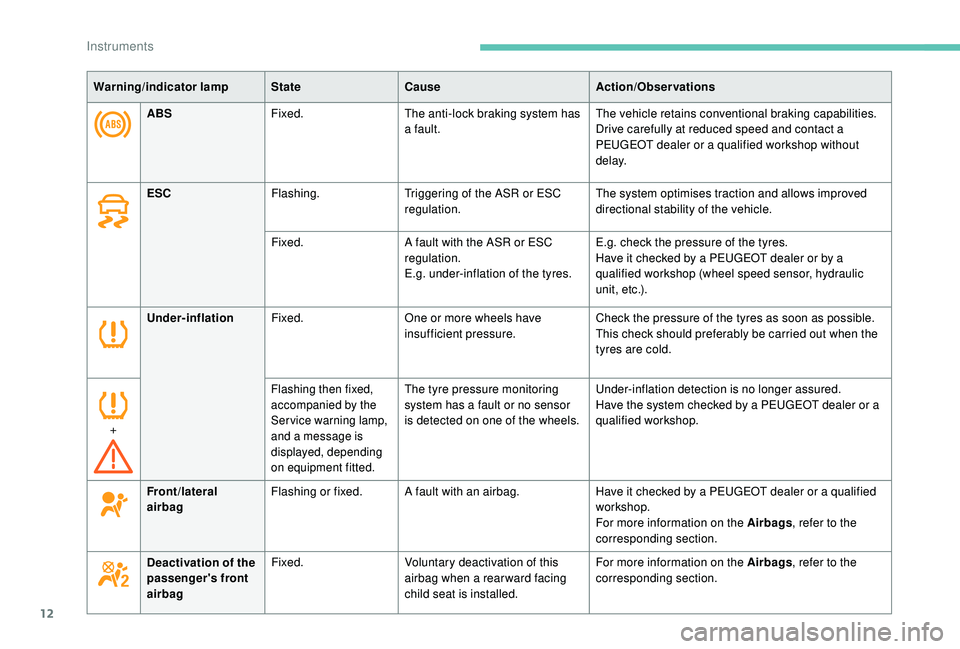
12
ABSFixed. The anti-lock braking system has
a fault. The vehicle retains conventional braking capabilities.
Drive carefully at reduced speed and contact a
PEUGEOT dealer or a qualified workshop without
d e l ay.
Warning/indicator lamp
StateCause Action/Observations
ESC Flashing. Triggering of the ASR or ESC
regulation. The system optimises traction and allows improved
directional stability of the vehicle.
Fixed. A fault with the ASR or ESC
regulation.
E.g. under-inflation of the tyres. E.g. check the pressure of the tyres.
Have it checked by a PEUGEOT dealer or by a
qualified workshop (wheel speed sensor, hydraulic
unit, etc.).
Under-inflation Fixed. One or more wheels have
insufficient pressure. Check the pressure of the tyres as soon as possible.
This check should preferably be carried out when the
tyres are cold.
+
Flashing then fixed,
accompanied by the
Service warning lamp,
and a message is
displayed, depending
on equipment fitted.The tyre pressure monitoring
system has a fault or no sensor
is detected on one of the wheels. Under-inflation detection is no longer assured.
Have the system checked by a PEUGEOT dealer or a
qualified workshop.
Front/lateral
airbag Flashing or fixed.
A fault with an airbag. Have it checked by a PEUGEOT dealer or a qualified
workshop.
For more information on the Airbags , refer to the
corresponding section.
Deactivation of the
passenger's front
airbag Fixed.
Voluntary deactivation of this
airbag when a rear ward facing
child seat is installed. For more information on the Airbags
, refer to the
corresponding section.
Instruments